| 蒙脱石剥离二维纳米片及其功能化应用 |
2. 武汉理工大学 资源与环境工程学院,湖北 武汉 430070
2. School of Resources and Environmental Engineering, Wuhan University of Technology, Wuhan 430070, Hubei, China
具有天然层状堆叠结构的矿物,由于结构效应而具有一些特殊的物理化学性质[1]。随着对层状矿物结构的深入研究,研究者们已从天然层状矿物中分离出只有几个纳米厚度甚至是单原子层的矿物纳米片,代表性的例子就是石墨烯的剥离和制备[2, 3]。这种剥离出的超薄纳米片片径尺寸通常在100 nm以上甚至为微米级或更大,厚度通常只有一个或几个原子层的厚度(通常小于5 nm),这种二维空间内的超薄层状结构即所谓的“二维结构”[4-7],这种特殊的低维结构使二维材料具有区别于其层状前体的微观物理效应如尺寸效应、缺陷效应、量子限域效应和热效应等。并且,剥离会使层状矿物的层间表面暴露而使比表面积显著提升,甚至可以超过1 000 m2/g,从而具有良好的晶体表面效应[8]。剥离暴露出的新鲜表面具有大量活性反应位点,使这类二维材料能够用于制备如超级电容器等先进材料[9, 10]。电子在纳米片层的二维空间中的量子限域效应也为制备电子材料的能带设计提供了便利。因此二维材料是制备先进功能材料的理想原料,目前已经在传感器和光敏气敏等设备设计中表现出巨大的应用潜力[7, 11, 12]。
以蒙脱石(Montmorillonite, MMT)为代表的黏土矿物也具有天然的层状结构,并且是构成地壳的主要矿物之一,种类丰富化学性质稳定。蒙脱石片层结构是由2层硅氧四面体层和1层铝氧八面体层构成的2 : 1型“三明治”结构(图 1a、b),层间由范德华力(Van der Waals Force)和静电力(Electrostatic Force)这类弱作用力连接[13]。当蒙脱石在水中时,由于层间渗透作用会使水分子进入蒙脱石层间,撑大蒙脱石片层间距从而发生水化膨胀,且不同种类的层间阳离子会对蒙脱石水化膨胀产生不同的影响[15]。
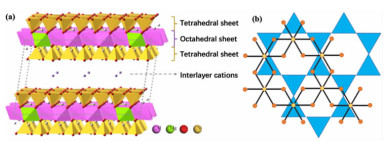 |
| 图 1 (a) 蒙脱石层状晶体结构示意图(b)蒙脱石晶层硅氧四面体和铝氧八面体俯视示意图 Fig.1 (a) Schematic diagram of montmorillonite layered crystal structure; (b) Top view of montmorillonite crystal layer Si-O tetrahedron and Al-O octahedron |
由于蒙脱石具有特殊的水化膨胀和易剥离的特性,研究者们已经成功将蒙脱石的层状结构完全剥离,制备具有二维结构特性的蒙脱石纳米片并进行功能化应用[16]。以蒙脱石为代表的天然层状黏土矿物来源广泛廉价易得,并且有着极佳的热稳定性和化学稳定性,类比于“材料基因组计划”,在将黏土矿物资源内在特性反映于制备的矿物材料之后,继而从应用需求出发倒推到矿物功能材料的制备和可控合成,将会极大丰富包括蒙脱石在内的各种黏土矿物在各个生产和研究领域的应用。因此,本文综述了蒙脱石二维纳米片的剥离制备以及基于二维蒙脱石纳米片的功能化应用的相关研究进展,为蒙脱石这类层状矿物的高值化应用提供参考。
1 蒙脱石剥离由于剥离过程与二维纳米片的性质直接相关,研究和调控蒙脱石剥离过程是制备蒙脱石二维纳米片的基础和关键[17, 18]。蒙脱石常用的剥离方法有化学法剥离、物理法(机械法)剥离以及化学-机械法剥离。
1.1 化学法剥离蒙脱石化学剥离方法根据所用化学剥离助剂的种类分为无机化学剥离方法和有机化学剥离方法。无机剥离剂主要通过离子交换作用进入蒙脱石层间域,有机剥离剂则是通过插层反应使蒙脱石层间距扩大。郑翔等[25]对比了无机剥离剂(氯化锂)、有机剥离剂(正丁基锂)以及有机酸剥离剂(葡萄糖酸)三种剥离剂对蒙脱石的剥离效果。剥离后对蒙脱石的测试表明,采用正丁基锂为剥离原矿后,X射线衍射图谱中蒙脱石001晶面的衍射峰基本消失,剥离效果最佳;采用氯化锂和葡萄糖酸剥离后的蒙脱石衍射图谱中001晶面衍射峰位略微减小,层间距有轻微的扩大,晶层有序度降低。
对于蒙脱石有机插层剥离,是通过有机长碳链分子或离子以共价键和离子键等作用力与蒙脱石片层结合,使蒙脱石晶层表面由亲水变为疏水,撑大蒙脱石层间距减小层间结合作用[26]。当蒙脱石层间距扩大到极限后即可得到无序的蒙脱石片层分散体系,即实现蒙脱石的剥离。通常采用的有机插层剂有胺类离子、有机酸和烷基酚等。吴选军等[27]利用阳离子活性剂十六烷基三甲基溴化铵(CTAB)和聚乙二醇(PEG)对提纯后的钠基蒙脱石进行插层处理制备了具有双官能团的有机改性蒙脱石。测试结果表明PEG分子和CTA+阳离子进入了蒙脱石层间,蒙脱石层间距从1.248 nm增大至3.044 nm,插层作用明显。
1.2 机械法剥离对于蒙脱石这类层间结合作用相对较弱的层状黏土矿物而言,一定强度的高速剪切作用力或超声作用力就能够克服层间结合作用而分离出二维蒙脱石片层单体。传统剥离方法如湿法机械球磨可使蒙脱石在与球磨介质不断碰撞和磨剥过程中解体分散[29],但难以分离出具有二维结构的单层蒙脱石纳米片。作者课题组[30, 31]采用超声剥离的方法成功剥离出具有高径厚比的二维蒙脱石纳米片,并系统研究了蒙脱石层间阳离子种类对蒙脱石剥离性质的影响,发现各种蒙脱石层间阳离子自身的电荷特性会对蒙脱石层内的Si-O化学键和Al-O化学键的强度产生不同程度的影响,并且会造成蒙脱石层间结合能的改变,使蒙脱石表现出与层间阳离子种类相关的剥离性质差异(图 2)。
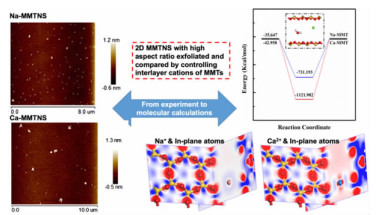 |
| 图 2 蒙脱石层间阳离子种类对超声法剥离制备蒙脱石二维纳米片的影响[31] Fig.2 Influence of cation types of montmorillonite on the preparation of two-dimensional montmorillonite nanosheets by ultrasonic stripping [31] |
基于单一超声法剥离蒙脱石制备二维纳米片的研究,作者团队[32]首次提出了循环冷冻解冻法超声辅助剥离蒙脱石的新方法,利用循环冷冻/解冻过程中蒙脱石层间水分子在相变过程中的体积膨胀,增大蒙脱石的片层间距,再辅以低强度超声处理即可实现蒙脱石的剥离,示意图如图 3a所示,剥离后蒙脱石d001峰明显宽化甚至消失,表明剥离处理使蒙脱石晶体有序度明显降低,层状结构被破坏(图 3b)。剥离得到的二维蒙脱石纳米片的一项重要的性能指标就是其径厚比(片径尺寸/片层厚度),蒙脱石原矿径厚比只有10左右,而剥离后二维蒙脱石纳米片径厚比提高至约120。并且对已剥离分离出的二维纳米片来说,具有高径厚比(即片径尺寸更大)的蒙脱石纳米片在与高分子复合的材料体系中能明显提高复合材料的各项机械性能和热稳定性,相较于小片径的纳米片能提供更多的表面反应活性位点。作者团队提出的这种新剥离方法能有效保护蒙脱石二维纳米片的片径尺寸,有利于大尺寸二维蒙脱石纳米片的制备。
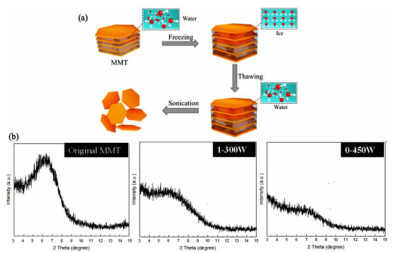 |
| 图 3 (a) 超声-冷冻解冻法循环剥离蒙脱石示意图;(b)未剥离蒙脱石和超声-冷冻/解冻循环剥离后的蒙脱石XRD图谱[32] Fig.3 (a) Schematic of cyclic exfoliation of montmorillonite by ultrasonic-freeze thawing method; (b) XRD patterns of montmorillonite after exfoliation without exfoliation and cyclic exfoliation by ultrasonic-freezing / thawing method[32] |
1.3 化学-机械法剥离
此种剥离方法是将化学改性柱撑蒙脱石和机械剥离方法相结合,发挥两种剥离方法的优点来制备稳定分散的二维蒙脱石纳米片。LeeStevens等[33]人先采用阳离子表面活性剂十二烷基三甲基溴化胺(CTAB)对蒙脱石进行表面改性,之后继续在超声处理条件下对蒙脱石进行进一步剥离,并在剥离进行的同时将二元胺离子嫁接到比表面积显著增大的蒙脱石片层上。Zhong等[34]人则是首先用季铵盐-18对蒙脱石进行有机改性,得到的有机蒙脱石置于二甲苯溶剂环境中继续进行超声剥离,有机改性插层结合超声剥离后的蒙脱石的XRD测试表明,化学-机械法剥离处理使蒙脱石d001特征峰几乎完全宽化消失,蒙脱石层状晶体结构被破坏。
2 二维蒙脱石纳米片的功能化应用剥离后的二维蒙脱石纳米片由于其优异的结构特性和化学稳定性,是制备各种功能材料的理想原料,目前已有许多基于蒙脱石纳米片材料化的研究,并已广泛应用于环境、能源、传感器等热门领域,推动了黏土矿物高值化应用的进展。
2.1 环境功能材料水体环境污染问题是近年来制约可持续发展的巨大阻碍,并且对人类生命安全和健康构成潜在威胁。作者课题组将剥离制备的二维蒙脱石纳米片与有机高分子黏结剂复,成功制备出一系列可用做高效吸附剂的二维蒙脱石纳米片基环境功能材料。蒙脱石纳米片不仅作为材料骨架提供了多孔结构和大比表面积,而且剥离后的蒙脱石暴露出更多的表面反应活性位点,有利于功能性分子的结合和吸附,蒙脱石表面天然负电性和边缘羟基基团以及良好的化学和热稳定性也为其作为复合吸附剂提供了巨大的应用优势。王伟[35, 36]和康石长[37]等人将超声剥离得到的蒙脱石二维纳米片与链状有机高分子壳聚糖(Chitosan,CS)通过蒙脱石片层边缘铝羟基(Al-OH)和壳聚糖链上的官能团(-NH3+)相结合,制备了具有三维结构的蒙脱石水凝胶(MMTNS-CShydrogel),如图 4所示。制备的蒙脱石水凝胶具有疏松多孔的轻质结构,吸水保水能力很强,对水溶液中重金属污染物Pb2+的吸附量最高可达约45 mg/g,对有机染料亚甲基蓝(Methyleneblue,MB)的吸附量可达约530 mg/g,吸附效果远高于未剥离蒙脱石或其他改性蒙脱石和活性炭等常用吸附剂。近期,赵云良[40]又提出了一种铁-壳聚糖/蒙脱石复合凝胶(Fe-CS/MMTNS),对MB进行吸附和光芬顿反应协同处理,该复合凝胶能够在广泛pH范围内保持对MB的高效降解(图 5a),并表现出极佳的循环稳定性(图 5b),其协同作用机理如图 5c所示:一部分MB直接被光芬顿产生的羟基自由基氧化而发生脱甲基作用,还有部分MB则是先吸附在Fe-CS/MMTNS凝胶上然后再被羟基自由基氧化降解。
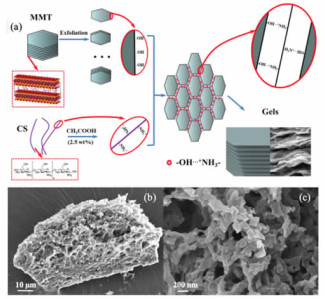 |
| 图 4 (a) 蒙脱石二维纳米片与壳聚糖自组装制备水凝胶机理图及(b,c)水凝胶的三维网状结构[36] Fig.4 (a) Mechanism of self-assembly of montmorillonite two-dimensional nanosheets and chitosan to prepare hydrogel; (b, c) Three-dimensional network structure of hydrogel[36] |
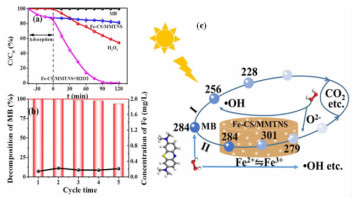 |
| 图 5 (a) 铁-壳聚糖/蒙脱石自组装凝胶对亚甲蓝的吸附和降解去除率,pH=3;(b)铁-壳聚糖/蒙脱石自组装凝胶循环性能;(c)铁-壳聚糖/蒙脱石自组装凝胶吸附/光芬顿反应协同降解亚甲基蓝机理图[40] Fig.5 (a) Adsorption and decomposition of MB by self-assembly Fe-CS-MMTNS gel, pH=3; (b)Recyclability of self-assembly Fe-CS-MMTNS gel; (c) Schematic diagram of MB decomposed by synergistic effect of adsorption and photo-Fenton reaction by self-assembly Fe-CS-MMTNS gel[40] |
在MMTNS-CS水凝胶的基础上,作者团队王伟[41]等人继续利用二维蒙脱石纳米片制备了一种多孔有机高分子复合材料(Porous organic polymer,POP),即采用聚乙烯醇(PVA)、海藻酸钠(SA)和壳聚糖(CS)与蒙脱石纳米片复合制备直径约3 mm的凝胶微球(图 6a,b)。凝胶球内部可看到均匀分布的微孔结构(图 6c,d),蒙脱石纳米片起到了骨架支撑作用,且对MB同样具有很好的吸附去除效果。陈鹏等[42]人则是首先将CS负载在聚苯乙烯(polystyrene,PS)微球表面,然后将表面修饰的PS颗粒浸入剥离后的蒙脱石纳米片分散液中,通过层层自组装形成核-壳结构,之后通过煅烧去除PS内核得到中空的壳聚糖-蒙脱石球形外壳(MMTNS@CS-HMPHS)(图 6e-g)。制备的蒙脱石球状外壳表面具有通向内部的介孔通道,球壳内部因与壳聚糖结合而具有与外表面不同的活性位点;其大比表面积和差异性的活性位点分布可用于吸附和用作催化剂载体等。
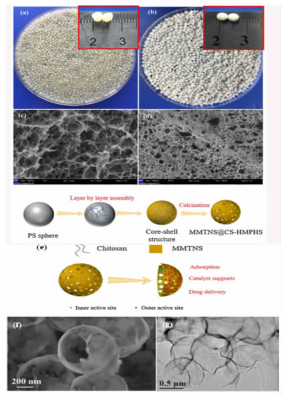 |
| 图 6 (a) PVA/SA/CTS-MMTNS凝胶球;(b)冷冻干燥后的PVA/SA/CTS-MMTNS凝胶球;(c)(d)为凝胶球内部多孔结构的SEM形貌图[41];(e)CS-MMTNS中空层状球壳制备过程; (f)CS-MMTNS中空层状球壳SEM测试形貌;(g)CS-MMTNS中空球壳TEM测试形貌[42] Fig.6 (a) PVA/SA/CTS-MMTNS gel sphere; (b) PVA/SA/CTS-MMTNS gel sphere after freeze drying; (c) & (d) SEM morphology of the porous structure inside the gel sphere[41]; (e) Preparation of CS-MMTNS hollow layered spherical shell; (f) SEM morphology of CS-MMTNS hollow layered spherical shell; (g) TEM morphology of CS-MMTNS hollow spherical shell[42] |
除水体中的重金属离子和有机染料污染外,温室气体CO2的大量排放对全球气候产生的影响也是迫在眉睫的环境问题。常用的烷烃醇胺溶液处理CO2能力不足,且其自身毒性和腐蚀性容易造成二次污染[43]。能够负载胺的黏土矿物由于天然的笼状或层状结构以及良好的生物相容性和化学稳定性受到越来越多的关注。Lee[33]等人首先用阳离子表面活性剂CTAB对蒙脱石进行插层改性,再将CTAB插层蒙脱石至于甲苯溶剂中进行超声剥离,再将二元胺基团嫁接到剥离的蒙脱石纳米片表面。该胺改性蒙脱石吸附剂在100 ℃纯CO2气氛中最大吸附量为2.4 mmol/g,均高于其他胺改性吸附材料,并且在吸附/解吸循环中最大吸附容量基本保持不变。
二维蒙脱石纳米片在上述对于环境污染水处理和温室气体吸附方面的研究展现出其作为二维材料原料的结构优势和黏土矿物天然物化特性在合成材料过程中的关键性作用,相较于传统环境材料,二维蒙脱石制备的功能各异的环境功能材料具有明显的应用优势。
2.2 储能材料传统高度依赖不可再生化石能源的模式将面临越来越严重的能源危机。相变材料(Phase change material,PCM)可通过相变的方式将太阳能、地热能等清洁能量储存起来以便于后续应用,是具有广阔应用前景的新型储能材料[44, 45]。由于相变材料的潜热特性和相变过程的存在,对相变物质的稳定封装是相变材料应用的关键,相较于常用的高分子薄膜和造价高昂的石墨烯,作者团队的易浩[46, 47]等人以二维蒙脱石纳米片为外壳,通过自组装方式包裹硬脂酸(stearicacid,SA)成功制备出了一种具有核-壳结构的新型复合相变储能材料,具有极高的相变内核容量(质量比超过80%)(图 7a),潜热容可达184.88 J/g。蒙脱石纳米片层构成的外壳能有效防止硬脂酸在相变过程中的泄漏,在50次循环储能放热之后的潜热容几乎保持不变(图 7b,c),且蒙脱石纳米片外壳的包裹明显提升了硬脂酸升温速率,表现出了优异的光热转化性能。詹伟泉等[48]人向MMTNS-SA相变体系中引入银纳米颗粒(AgNPs),并分别将银纳米颗粒负载在二维蒙脱石片层上和硬脂酸相变内核上,发现硬脂酸-银纳米颗粒复合内核包裹二维蒙脱石外壳的相变材料体系热导率使单一硬脂酸热导率提升229.3%,由于相变材料传热能力主要由占整体质量80%以上的相变内核决定的,故银纳米颗粒负载在硬脂酸内核上比负载在二维蒙脱石表面对相变体系热导率提升效果更佳(图 7d)。
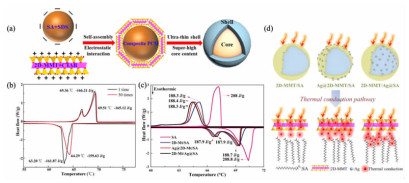 |
| 图 7 (a) 二维蒙脱石-硬脂酸相变储能材料制备及结构示意图;(b)MtNs-SA的DSC曲线和(c)引入AgNPs后先变材料的DSC曲线;(d)AgNPs分布位置与对应传热路径示意图[46-48] Fig.7 (a) Preparation and structure of two-dimensional montmorillonite-stearic acid phase change energy storage material; (b) DSC curves of MtNs-300/SA PCM; (c) DSC curve of the material first changed after the introduction of AgNPs; (d) Schematic diagram of AgNPs distribution locations and corresponding heat transfer paths[46-48] |
剥离制备的二维蒙脱石纳米片制备的复合相变材料不仅表现出了极佳的循环稳定性,并且蒙脱石表面的负电荷和大比表面积有利于与相变材料或其他功能性基团的结合,化学性质稳定的天然黏土矿物是制备这类相变储能材料的理想原料。
2.3 阻燃材料大多数广泛应用于日常生产和生活中的高分子聚合物塑料属于易燃材料的范畴,在使用过程中可能会造成安全隐患[49]。通常对这类材料的阻燃处理是通过添加无机填料来实现[50]。天然层状黏土矿物化学性质稳定,具有极佳的热稳定性,剥离分散的纳米片层分散体系更是可用做复合材料的结构增强剂。已有多研究者开展了关于层状黏土应用于高分子材料特别是提升高分子材料阻燃性方面的研究。
陈鹏等[51]人通过层层自组装的方法用壳聚糖连接将二维蒙脱石纳米片负载在聚氨酯(FPU)泡沫表面,蒙脱石纳米片能在FPU表面形成致密完整的蒙脱石膜阻隔氧气和挥发性气体的释放并抑制热传递从而达到更佳的阻燃效果,极大提升了聚氨酯泡沫的阻燃性(图 8)。Ding等[52]人通过模仿天然珍珠层的无机-有机层状结构,将链状有机高分子聚乙烯醇树脂(PVA)和聚对苯二甲酸乙二醇酯(PET)作为连接剂与二维蒙脱石纳米片层自组装制备了一种纳米仿生层状材料。在这种有序的均匀插层体系中蒙脱石不仅作为结构骨架提供强度,而且表现出了优异的阻燃能力(图 9)。
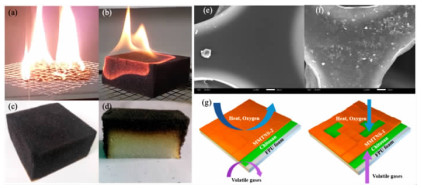 |
| 图 8 (a) FPU和负载蒙脱石后(b)FPU燃烧以及负载蒙脱石FPU燃烧后的(c)表面与(d)截面图;(e)FPU和(f)负载蒙脱石纳米片后的FPU的SEM形貌图;(g)不同厚度蒙脱石层阻燃机理示意图[51] Fig.8 (a) Surface of FPU combustion process; (b) Surface of FPU combustion process after loading montmorillonite; (c) Loaded montmorillonite FPU surface after combustion; (d) Loaded montmorillonite FPU cross-section after combustion; (e) SEM morphology of FPU; (f) SEM morphology of FPU after loading montmorillonite nanosheets; (g) Schematic diagram of flame retardant mechanism of montmorillonite layers with different thickness[51] |
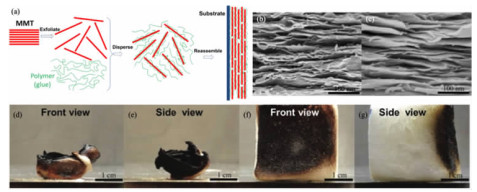 |
| 图 9 (a) 层状有序排列蒙脱石纳米复合材料制备过程示意图;PVA/MMT薄膜在燃烧实验(b)前(c)后的截面SEM图像;PU燃烧后的(d)主视图和(e)俯视图以及负载PVA/MMT的PU燃烧后(f)主视图和(g)俯视图[52] Fig.9 (a) Schematic diagram of the preparation process of layered ordered montmorillonite nanocomposites; (b) SEM morphology of cross section of PVA / MMT film before combustion experiment; (c) SEM morphology of cross section of PVA / MMT film after combustion experiment; (d) Front view of PU after combustion; (e) Top view of PU after combustion; (f) Front view of PU with PVA / MMT after combustion; (g) Top view of PU with PVA / MMT after combustion[52] |
2.4 纳米流体通道
当流体被限制在极小的纳米级通道内时,其传输行为和流体性质会受到通道表面特征的影响而表现出优于普通流体的传输性质[53]。组装纳米流体通道的前驱材料的表面性质直接决定了流体在其中的传输行为。黏土二维纳米片层表面的天然带电性使其在水溶液中具有双电层结构,当相邻片层间距为1~3 nm时片层表面双电层会发生重叠,当流体在这种通道中传输时,通道表面电荷与流体离子或分子的静电作用会对流体的传输产生极大的影响(德拜效应)[54-57]。这种受通道表面电荷调控的流体行为可用于离子的选择性输送或能量转化/储存及智能响应材料等领域[58-60],具有很大的研究和应用潜力。
Liu等[61]人将剥离的单层锂基蒙脱石通过真空抽滤法制备为具有均匀二维通道的柔性薄膜,得益于黏土矿物优异的天然热稳定性,二维通道在400 ℃热处理后仍保持完整的层结构和流体传输性能,且在电解质溶液浓度低于10-4 M时表现出受表面电荷调控的离子传输行为。这种低浓度溶液中的离子传输特性也使蒙脱石基二维流体通道可用做能量转化装置,其制备过程可控且耐盐耐酸,具有替代盐差发电中电渗析膜的潜力。Zhou等[62]人成功实现了蒙脱石组装的流体通道用于能量转化。超声剥离后的蒙脱石纳米片重新组装为具有均匀二维通道结构的蒙脱石柔性薄膜(图 10a-c),且在低浓度电解质溶液中表现出受通道电荷调控的离子传输行为(图 10d,e)。图 10f,10g为通道两端为不同浓度梯度的盐溶液时,在广泛pH值环境中都监测到了不同大小的扩散电流,实现了盐差发电。这种采用黏土矿物重组装的多功能通道材料充分发挥了黏土矿物本身的优异天然特性,是未来先进矿物功能材料的研发和廉价黏土高值化应用的发展新方向。
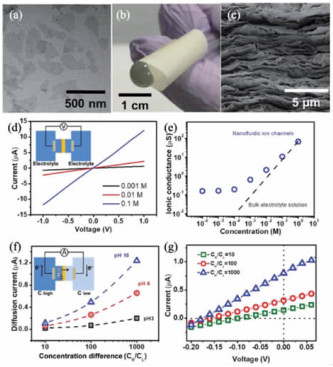 |
| 图 10 (a) 剥离蒙脱石纳米片TEM测试图;(b)CTAB改性蒙脱石纳米片重组装制备的具有二维通道的柔性薄膜(RMM);(c)RMM截面层状结构SEM测试图;RMM离子传输特性测试:(d)在不同浓度KCl溶液中的Ⅰ-Ⅴ曲线(e)电解质浓度与质子传导效率间的关系;RMM能量转化测试:(f)不同pH条件下歌浓度梯度产生的扩散电流(g)不同浓度梯度(1,10,100)下的Ⅰ-Ⅴ曲线[62] Fig.10 (a) TEM images of exfoliated MMT nanosheets; (b) Flexible film (RMM) with two-dimensional channel prepared by CTAB modified montmorillonite nanosheets; (c) SEM morphology of RMM cross-section layered structure; (d) Ⅰ-Ⅴ curve of different concentrations of KCl solution in RMM ion transmission characteristic test; (e) Relationship between electrolyte concentration and proton conduction efficiency in RMM ion transmission characteristic test; (f) Ⅰ-Ⅴ curve of diffusion current generated by each concentration gradient in different pH conditions in RMM energy conversion test; (g) Ⅰ-Ⅴ curve at different concentration gradients (1, 10, 100) in RMM energy conversion test[62] |
2.5 智能材料
科学技术的发展就是逐渐解放生产力的过程,越来越多的生产过程需要自动化生产的解决方案,这也带动了智能(响应性)材料的发展[63, 64]。目前已开发出对各种刺激如力、热、光、湿度和pH值等作出响应的纳米复合材料[65-67]。这种特性响应可用于传感器的制备和各种预警系统之中。
Cheng等[69]人设计了一种蒙脱石基热变色材料,通过氢键连接将戊二醛酸(PCDA)单体涂布在蒙脱石二维纳米片上,在254 nm紫外光照射下PCDA单体自聚合成聚戊二醛酸并与(3-氨丙基)三乙氧基硅烷(APTES)交联,最终获得了具有可逆热致变色特性的MMT/poly-PCDA/APTES杂化膜(图 11a),其热变色机理是由于侧链在升温或降温过程中的热运动导致层间聚合物链共轭长度的延长和缩短(图 11b)。除颜色改变外,材料形变是也是一种常用的刺激响应形式,Gogoi等[70]人将剥离后的蒙脱石纳米片和蛭石纳米片复合制备了一种新型的刺激响应双层黏土薄膜(clay-clay bilayer membrane, CCBM)(图 11c)。发现所制备的CCBM在暴露于各种蒸气(包括甲醇、丙酮、四氢呋喃、乙醇、2-丙醇和乙酸乙酯)后均会发生形变。此外,不同的大气湿度(图 11d)和环境温度的波动(图 11e)刺激下,CCBM均相应表现出不同的形变特征,这是由于CCBM两侧两种黏土矿物对湿度和温度刺激的响应程度不同而使其表现出特异性响应环境刺激的形变效果(图 11f)。
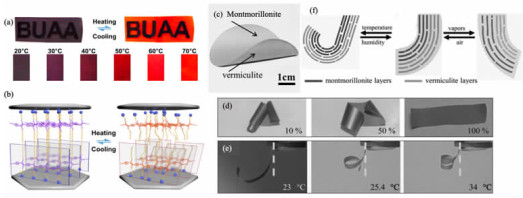 |
| 图 11 (a) 制备的MMT-polyPCDA-APTES薄膜的热变色性质, (b)热变色机理示意图[69];(c)蒙脱石-蛭石双层黏土基薄膜(CCBM);在不同湿度(d)和不同环境温度(e)中CCBM的形变情况;(f)组分形变差异造成双层异质结构发生弯曲机理示意图[70] Fig.11 (a) Thermochromic properties of MMT-poly PCDA-APTES nacre-like membrane, (b)Schematic diagram of thermochromic mechanism[69]; (c) Digital image of MMT-VMT clay-clay bilayer membrane (CCBM); (d) Deformation of CCBM under different humidity; (e) Deformation of CCBM under different environment temperature; (f) Schematic diagram of the bending mechanism of the double-layer heterostructure caused by the difference in component deformation[70] |
上述研究充分说明了基于蒙脱石制备超灵敏、多响应、高度耐用、经济环保的智能响应材料的可能性。蒙脱石纳米片的成功应用也为其他种类黏土矿物构造矿物功能性膜材料指明了方向,如从昼夜温度和环境湿度变化中吸收转化能量以及高生物相容性智能设备的设计,为新型层状矿物的研究和应用提供了更多可能。
3 结语在蒙脱石从传统的简单磨剥和插层改性到作为二维材料制备先进功能材料的发展过程中,蒙脱石的天然层状结构和化学特性得到了深入的研究和应用,剥离得到的二维蒙脱石纳米片已经在环境领域、能源与化工领域和智能化制造方面取得了开拓性的应用进展。基于功能材料特异性需求为反馈的前期蒙脱石剥离调控及二维蒙脱石纳米片表面修饰的研究思路,以蒙脱石为基础的矿物功能材料制备全过程将启发其他具有优异特性的天然矿物的研究和应用,促进二维材料家族的发展,新型二维材料的发掘和研究对矿物功能材料的生产和应用具有积极的现实意义。
| [1] |
SKIPPER N T, SPOSITO G, SOPER A K. Surface geochemistry of the clay minerals[J]. Proceedings of the National Academy of Sciences of the United States of America, 1999, 96(7): 3358-3364. DOI:10.1073/pnas.96.7.3358 |
| [2] |
Stankovich S, Dikin D A, Dommett G H B, et al. Graphene-based composite materials[J]. Nature, 2006, 442(7100): 282-286. DOI:10.1038/nature04969 |
| [3] |
Geim A K. Graphene:status and prospects[J]. Science, 2009, 5934(324): 1530-1534. |
| [4] |
Mas-Ballesté R G C G J. 2D materials:to graphene and beyond[J]. Nanoscale, 2011, 1(3): 20-30. |
| [5] |
Bhimanapati G R, Lin Z, Meunier V, et al. Recent Advances in two-dimensional materials beyond graphene[J]. ACS Nano, 2015, 9(12): 11509-11539. DOI:10.1021/acsnano.5b05556 |
| [6] |
Ling X, Lin Y, Ma Q, et al. Parallel stitching of 2D materials[J]. Advanced materials, 2016, 28(12): 2322-2329. DOI:10.1002/adma.201505070 |
| [7] |
Bonaccorso F, Colombo L, Yu G, et al. 2D materials. Graphene, related two-dimensional crystals, and hybrid systems for energy conversion and storage[J]. Science, 2015, 347(6217): 1246501. DOI:10.1126/science.1246501 |
| [8] |
Zhu T T, Zhou C H, Kabwe F B, et al. Exfoliation of montmorillonite and related properties of clay/polymer nanocomposites[J]. Applied Clay Science, 2019, 169: 48-66. DOI:10.1016/j.clay.2018.12.006 |
| [9] |
Liu Z, Teng Y, Teng F, et al. Charge storage performances of micro-supercapacitor predominated by two-dimensional (2D) crystal structure[J]. Nano Energy, 2016, 27: 58-67. DOI:10.1016/j.nanoen.2016.06.025 |
| [10] |
Zhang L, Yao H, Li Z, et al. Synthesis of delaminated layered double hydroxides and their assembly with graphene oxide for supercapacitor application[J]. Journal of Alloys and Compounds, 2017, 711: 31-41. DOI:10.1016/j.jallcom.2017.03.348 |
| [11] |
Szendrei-Temesi K S O B. Lithium tin sulfide-a high-refractive-index 2D material for humidity-responsive photonic crystals[J]. Advanced functional materials, 2018, 14(28): 1705740. |
| [12] |
Chauhan N, Chawla S, Pundir C S, et al. An electrochemical sensor for detection of neurotransmitter-acetylcholine using metal nanoparticles, 2D material and conducting polymer modified electrode[J]. Biosens Bioelectron, 2017, 89(Pt 1): 377-383. |
| [13] |
Brigattia M F, Galanb E, Thengc B K G. Charpter 2 structure and mineralogy of clay minerals[J]. Development of clay science, 2006(1): 19-86. |
| [14] |
Thomas A W L H. Adsorption studies on clay minerals Ⅸ. ion-exchange properties of natural and thermally altered montmorillonite[J]. Soil Science Society of America Journal, 1965, 3(29): 627-651. |
| [15] |
黄缓缓. 金属阳离子对蒙脱石水化膨胀影响的试验研究[J]. 选煤技术, 2018(4): 19-22. |
| [16] |
Zhou Y, LaChance A M, Smith A T, et al. Strategic design of clay-based multifunctional materials:from natural minerals to nanostructured membranes[J]. Advanced functional materials, 2019, 29(16): 1807611. DOI:10.1002/adfm.201807611 |
| [17] |
Nicolosi V, Chhowalla M, Kanatzidis M G. Liquid exfoliation of layered materials[J]. Science, 2013, 6139(340): 1226419. |
| [18] |
Coleman J N, Lotya M, O'Neill A, et al. Two-dimensional nanosheets produced by liquid exfoliation of layered materials[J]. Science, 2011, 331(6017): 568-571. DOI:10.1126/science.1194975 |
| [19] |
Park K H, Kim B H, Song S H, et al. Exfoliation of non-oxidized graphene flakes for scalable conductive film[J]. Nano letters, 2012, 12(6): 2871-2876. DOI:10.1021/nl3004732 |
| [20] |
Gintert M J, Jana S C, Miller S G. A novel strategy for nanoclay exfoliation in thermoset polyimide nanocomposite systems[J]. Polymer, 2007, 48(14): 4166-4173. DOI:10.1016/j.polymer.2007.05.053 |
| [21] |
Ang P K, Wang S, Bao Q, et al. High-throughput synthesis of graphene by intercalation-exfoliation of graphite oxide and study of ionic screening in graphene transistor[J]. ACS nano, 2009, 3(11): 3587-3594. DOI:10.1021/nn901111s |
| [22] |
Cano-Márquez A G, Rodríguez-Macías F J, Campos-Delgado J, et al. Ex-MWNTs:graphene sheets and ribbons produced by lithium intercalation and exfoliation of carbon nanotubes[J]. Nano letters, 2009, 9(4): 1527-1533. DOI:10.1021/nl803585s |
| [23] |
Thasirisap E, Vittayakorn N, Seeharaj P. Surface modification of TiO2 particles with the sono-assisted exfoliation method[J]. Ultrasonics Sonochemistry, 2017, 39: 733-740. DOI:10.1016/j.ultsonch.2017.06.002 |
| [24] |
Sanchez-Solis A, Garcia-Rejon A, Estrada M, et al. Properties of poly(ethylene terephthalate)-poly(ethylene naphthalene 2, 6-dicarboxylate) blends with montmorillonite clay[J]. Polymer international, 2005, 12(54): 1669-1672. |
| [25] |
郑翔, 孙海标, 张炫辉, 等. 蒙脱石剥离方法的对比与选择[J]. 矿物学报, 2014, 34(3): 427-432. |
| [26] |
Jiankun L, Yucai K, Zongneng Q, et al. Study on intercalation and exfoliation behavior of organoclays in epoxy resin[J]. Journal of Polymer Science Part B:Polymer Physics, 2000, 1(39): 115-120. |
| [27] |
吴选军, 袁继祖, 余永富. 双官能团有机改性蒙脱石的制备及性能[J]. 非金属矿, 2009, 32(4): 1-4. DOI:10.3969/j.issn.1000-8098.2009.04.001 |
| [28] |
Huang T, Chiou J, Wang Y, et al. Unusual exfoliation of layered silicate clays by non-aqueous amine diffusion mechanism[J]. Journal of Polymer Research, 2016, 23(8): 1-7. |
| [29] |
李存军, 卢红, 林茵茵, 等. 蒙脱石的湿法机械球磨剥离[J]. 硅酸盐通报, 2016, 35(5): 1372-1377. |
| [30] |
Bai H, Zhao Y, Zhang X, et al. Correlation of exfoliation performance with interlayer cations of montmorillonite in the preparation of two-dimensional nanosheets[J]. Journal of the American Ceramic Society, 2019, 102(7): 3908-3922. DOI:10.1111/jace.16285 |
| [31] |
Bai H, Zhao Y, Wang W, et al. Effect of interlayer cations on exfoliating 2D montmorillonite nanosheets with high aspect ratio:From experiment to molecular calculation[J]. Ceramics International, 2019, 45(14): 17054-17063. DOI:10.1016/j.ceramint.2019.05.257 |
| [32] |
Chen T, Yuan Y, Zhao Y, et al. Preparation of montmorillonite nanosheets through freezing/thawing and ultrasonic exfoliation[J]. Langmuir:the ACS journal of surfaces and colloids, 2019, 35(6): 2368-2374. DOI:10.1021/acs.langmuir.8b04171 |
| [33] |
Stevens L, Williams K, Han W Y, et al. Preparation and CO2 adsorption of diamine modified montmorillonite via exfoliation grafting route[J]. Chemical Engineering Journal, 2013, 215-216: 699-708. DOI:10.1016/j.cej.2012.11.058 |
| [34] |
Zhong Y, Wang S. Exfoliation and yield behavior in nanodispersions of organically modified montmorillonite clay[J]. Journal of Rheology, 2003, 47(2): 483-495. DOI:10.1122/1.1545074 |
| [35] |
Wang W, Zhao Y, Yi H, et al. Pb(Ⅱ) removal from water using porous hydrogel of chitosan-2D montmorillonite[J]. International Journal of Biological Macromolecules, 2019, 128: 85-93. DOI:10.1016/j.ijbiomac.2019.01.098 |
| [36] |
Wang W, Zhao Y, Yi H, et al. Preparation and characterization of self-assembly hydrogels with exfoliated montmorillonite nanosheets and chitosan[J]. Nanotechnology, 2018, 29(2): 25605. DOI:10.1088/1361-6528/aa9ba4 |
| [37] |
Kang S, Zhao Y, Wang W, et al. Removal of methylene blue from water with montmorillonite nanosheets/chitosan hydrogels as adsorbent[J]. Applied Surface Science, 2018, 448: 203-211. DOI:10.1016/j.apsusc.2018.04.037 |
| [38] |
Ruppert G, Bauer R, Heisler G. The photo-Fenton reaction - an effective photochemical wastewater treatment process[J]. Journal of Photochemistry and Photobiology A:Chemistry, 1993, 73(1): 75-78. DOI:10.1016/1010-6030(93)80035-8 |
| [39] |
Comninellis C, Kapalka A, Malato S, et al. Advanced oxidation processes for water treatment advances and trends for R & D[J]. Journal of Chenmical Technology and Biotechnology, 2008, 6(83): 769-776. |
| [40] |
Zhao Y, Kang S, Qin L, et al. Self-assembled gels of Fe-chitosan/montmorillonite nanosheets:Dye degradation by the synergistic effect of adsorption and photo-Fenton reaction[J]. Chemical Engineering Journal, 2020, 379: 122322. DOI:10.1016/j.cej.2019.122322 |
| [41] |
Wang W, Zhao Y, Bai H, et al. Methylene blue removal from water using the hydrogel beads of poly(vinyl alcohol)-sodium alginate-chitosan-montmorillonite[J]. Carbohydr Polym, 2018, 198: 518-528. DOI:10.1016/j.carbpol.2018.06.124 |
| [42] |
Chen T, Chen P, Zhao Y, et al. Synthesis of montmorillonite-chitosan hollow and hierarchical mesoporous spheres with single-template layer-by-layer assembly[J]. Journal of Materials Science & Technology, 2019, 35(10): 2325-2330. |
| [43] |
Przepiórski J, Skrodzewicz M, Morawski A W. High temperature ammonia treatment of activated carbon for enhancement of CO2 adsorption[J]. Applied Surface Science, 2004, 225(1-4): 235-242. DOI:10.1016/j.apsusc.2003.10.006 |
| [44] |
Hong Y, Xin-shi G. Preparation of polyethylene-paraffin compound as a form-stable solid-liquid phase change material[J]. Solar Energy Materials and Solar Cells, 2000, 64(1): 37-44. DOI:10.1016/S0927-0248(00)00041-6 |
| [45] |
Alkan C, Sarı A, Karaipekli A, et al. Preparation, characterization, and thermal properties of microencapsulated phase change material for thermal energy storage[J]. Solar Energy Materials and Solar Cells, 2009, 93(1): 143-147. DOI:10.1016/j.solmat.2008.09.009 |
| [46] |
Yi H, Zhan W, Zhao Y, et al. A novel core-shell structural montmorillonite nanosheets/stearic acid composite PCM for great promotion of thermal energy storage properties[J]. Solar Energy Materials and Solar Cells, 2019, 192: 57-64. DOI:10.1016/j.solmat.2018.12.015 |
| [47] |
Yi H, Zhan W, Zhao Y, et al. Design of MtNS/SA microencapsulated phase change materials for enhancement of thermal energy storage performances:Effect of shell thickness[J]. Solar Energy Materials and Solar Cells, 2019, 200: 109935. DOI:10.1016/j.solmat.2019.109935 |
| [48] |
Zhan W, Zhao Y, Yuan Y, et al. Development of 2D-Mt/SA/AgNPs microencapsulation phase change materials for solar energy storage with enhancement of thermal conductivity and latent heat capacity[J]. Solar Energy Materials and Solar Cells, 2019, 201: 110090. DOI:10.1016/j.solmat.2019.110090 |
| [49] |
Kourtides D A, Parker J A. Assessment of relative flammability and thermochemical properties of some thermoplastic materials[J]. Polymer Engineering and Science, 1978, 18(11): 855-860. DOI:10.1002/pen.760181105 |
| [50] |
Camino G, Grassie N, McNeill I C. Influence of the fire retardant, ammonium polyphosphate, on the thermal degradation of poly(methyl methacrylate)[J]. Journal of Polymer Science:Polymer Chemistry Edition, 1978, 16(1): 95-106. DOI:10.1002/pol.1978.170160110 |
| [51] |
Peng C, Yunliang Z, Wei W, et al. Correlation of montmorillonite sheet thickness and flame retardant behavior of a chitosan-montmorillonite nanosheet nembrane assembled on flexible polyurethane foam[J]. Polymer, 2019, 213(11): 1-13. |
| [52] |
Ding F, Liu J, Zeng S, et al. Biomimetic nanocoatings with exceptional mechanical, barrier, and flame-retardant properties from large-scale one-step coassembly[J]. Sci Adv, 2017, 3(7): e1701212. DOI:10.1126/sciadv.1701212 |
| [53] |
Koltonow A R, Huang J. Ionic transport. Two-dimensional nanofluidics[J]. Science, 2016, 351(6280): 1395-1396. DOI:10.1126/science.aaf5289 |
| [54] |
Kim S J, Wang Y, Lee J H, et al. Concentration polarization and nonlinear electrokinetic flow near a nanofluidic channel[J]. Physical review letters, 2007, 99(4): 44501. DOI:10.1103/PhysRevLett.99.044501 |
| [55] |
Kim S J, Li L D, Han J. Amplified electrokinetic response by concentration polarization near nanofluidic channel[J]. Langmuir:the ACS journal of surfaces and colloids, 2009, 25(13): 7759-7765. DOI:10.1021/la900332v |
| [56] |
Cao Q, Zuo C, Li L, et al. Electroosmotic flow in a nanofluidic channel coated with neutral polymers[J]. Microfluidics and Nanofluidics, 2010, 9(6): 1051-1062. DOI:10.1007/s10404-010-0620-5 |
| [57] |
Pal Singh K, Kumar M, Kumari K. Field-effect control of electrokinetic ion transport in a nanofluidic channel[J]. Journal of Applied Physics, 2011, 110(8): 84301. DOI:10.1063/1.3651634 |
| [58] |
Lao J, Lv R, Gao J, et al. Aqueous stable Ti3C2 mxene membrane with fast and photoswitchable nanofluidic transport[J]. ACS Nano, 2018, 12(12): 12464-12471. DOI:10.1021/acsnano.8b06708 |
| [59] |
Barton R A, Ilic B, Verbridge S S, et al. Fabrication of a nanomechanical mass sensor containing a nanofluidic channel[J]. Nano letters, 2010, 10(6): 2058-2063. DOI:10.1021/nl100193g |
| [60] |
Cheng L, Cao D. Designing a thermo-switchable channel for nanofluidic controllable transportation[J]. ACS nano, 2011, 5(2): 1102-1108. DOI:10.1021/nn102754g |
| [61] |
Meili L, Meng H, Lianyu T, et al. Two-dimensional nanochannel arrays based on flexible montmorillonite membranes[J]. Acs Appl Mater Inter, 2018(10): 44915-44923. |
| [62] |
Zhou Y, Ding H, Smith A T, et al. Nanofluidic energy conversion and molecular separation through highly stable clay-based membranes[J]. Journal of Materials Chemistry A, 2019, 7(23): 14089-14096. DOI:10.1039/C9TA00801B |
| [63] |
Roy D, Cambre J N, Sumerlin B S. Future perspectives and recent advances in stimuli-responsive materials[J]. Progress in Polymer Science, 2010, 35(1): 278-301. |
| [64] |
Russell T P. Surface-responsive materials[J]. Science, 2002, 5583(297): 964-967. |
| [65] |
Wilson H R, Cantow H, Eck W. Semi-interpenetrating polymer networks with temperature-dependent light transmission-a new smart material for solar technology[J]. Advanced Materials, 1995, 7(9): 800-803. DOI:10.1002/adma.19950070909 |
| [66] |
Unger K, Salzmann P, Masciullo C, et al. Novel light-responsive biocompatible hydrogels produced by initiated chemical vapor deposition[J]. ACS applied materials & interfaces, 2017, 9(20): 17408-17416. |
| [67] |
Yang F, Guo Z. A facile approach to transform stainless steel mesh into pH-responsive smart material[J]. RSC Advances, 2015, 5(18): 13635-13642. DOI:10.1039/C4RA16607H |
| [68] |
Lavalle P, Voegel J, Vautier D, et al. Dynamic aspects of films prepared by a sequential deposition of species:perspectives for smart and responsive materials[J]. Advanced materials (Deerfield Beach, Fla.), 2011, 23(10): 1191-1221. DOI:10.1002/adma.201003309 |
| [69] |
Peng J, Cheng Y, Tomsia A P, et al. Thermochromic Artificial Nacre Based on Montmorillonite[J]. ACS applied materials & interfaces, 2017, 9(29): 24993-24998. |
| [70] |
Gogoi R K, Raidongia K. Strategic shuffling of clay layers to imbue them with responsiveness[J]. Advanced Materials, 2017, 29(24): 1701164. DOI:10.1002/adma.201701164 |
 2019
2019



